So, you’re on the hunt for a Guitar Power Chords Chart? You’ve landed in the right place. But let’s be honest, just a chart isn’t enough, is it? You want to actually play rock music, to create those powerful, driving sounds you hear in your favorite songs. You’re looking to unleash that raw energy from your guitar. Am I right?
If you just need a quick reference, here’s a guitar power chords chart to get you started. But stick around, because understanding how to use this chart is the real key to unlocking your rock potential.
Ready to rock? Download your printable power chord chart and let’s get started! Downloadable guitar power chords chart with power chord progressions – PDF (Right-click to save)
Unleashing the Power: Your Guitar Power Chords Chart
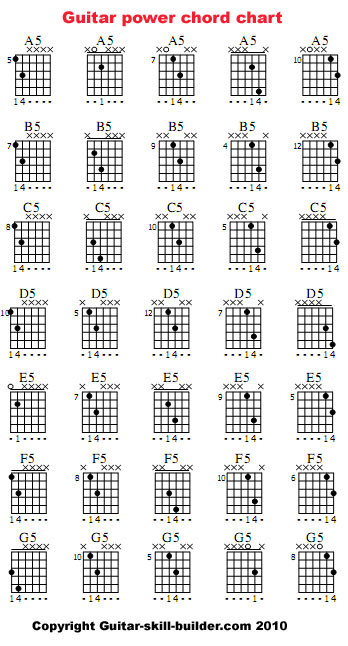 Guitar Power Chords Chart
Guitar Power Chords Chart
Alt text: Guitar Power Chords Chart displaying common power chord shapes across the fretboard for easy reference.
Power chords. The name itself sounds intense, doesn’t it? And that’s exactly what they are. Imagine the sound of a roaring guitar, the backbone of rock and blues anthems – that’s often power chords at work. To truly appreciate them, picture this: a cranked-up amplifier, maybe not to a full “10” (ears are precious!), but enough to feel the rumble. Even at a volume level of “7,” you’ll get the idea.
Why “power” chords? Because they deliver the most forceful, resonant sound you can get from a guitar chord. They are the bedrock of countless rock and blues tracks for a reason.
Are power chords difficult to learn? Absolutely not! In fact, mastering power chords is one of the quickest routes to sounding awesome on the guitar, especially for beginners.
Typically, power chords only require one, two, or at most three fingers – even for some of the more advanced variations. We’re planning to add video demonstrations soon to show you just how simple these chords really are to grasp.
New to reading guitar tabs? Don’t worry! Check out our guide on how to read guitar tabs here. It’ll get you up to speed in no time.
Now, let’s dive into making music. We’ll use the fundamental one, four, five chord progression – a musical foundation used in thousands of songs. These are the building blocks of countless hits. Don’t underestimate their power and versatility!
To get that extra “oomph” from your power chords, try using the fleshy part of your picking hand to lightly mute the strings as you strike them with your pick. This technique adds a percussive, meaty edge to your sound.
First, let’s tackle open power chords. Prepare yourself – you’ll only need one finger for these. I know, it sounds almost too easy, but you’ve got this!
Open Guitar Power Chord Tabs
 Alt text: Guitar tab showing open power chords A5, D5, and E5, demonstrating basic power chord shapes using open strings.
Alt text: Guitar tab showing open power chords A5, D5, and E5, demonstrating basic power chord shapes using open strings.
Next up: movable power chords. Get ready to use two fingers for these. You’re leveling up!
The beauty of movable power chords is that the same finger pattern or progression works all along the neck, across the 6th and 5th strings (the thickest two). Wherever you can place your finger on a fret, you can play a power chord.
The name of the power chord is determined by the note your first finger is pressing down. (If you’re still learning the notes on the fretboard, we have a fantastic tutorial to help you master it. Explore our fretboard learning guide.)
Start with the first chord shape, move to the second, then the third – and you’ve got the one, four, five progression we mentioned earlier. Simple yet incredibly effective!
Movable Guitar Power Chord Tabs (6th and 5th Strings)
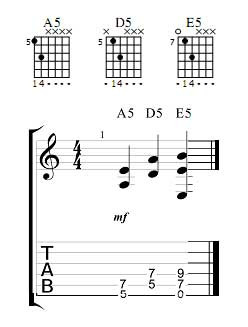 Alt text: Guitar tab illustrating movable power chord shapes on the 6th and 5th strings, showing how to slide the shape up and down the neck.
Alt text: Guitar tab illustrating movable power chord shapes on the 6th and 5th strings, showing how to slide the shape up and down the neck.
Now, let’s explore power chords on the 3rd and 4th strings. The principle remains the same: the root note (which gives the chord its name) is the note your first finger frets. (Master the fretboard with our easy learning method!) These power chords have a higher pitch, offering a different tonal flavor. Experiment with them and have fun! We’ll be adding more power chord variations soon, so check back regularly.
Guitar Power Chord Tabs (4th and 3rd Strings)
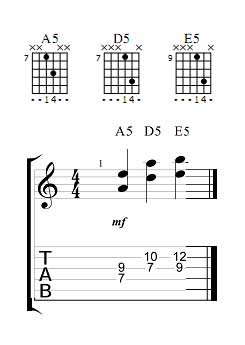 Alt text: Guitar tab demonstrating movable power chord shapes on the 4th and 3rd strings, providing higher-pitched power chord voicings.
Alt text: Guitar tab demonstrating movable power chord shapes on the 4th and 3rd strings, providing higher-pitched power chord voicings.
Want more chord charts? Click the thumbnails below!
Struggling with Barre Chords? Discover the secret to easier barre chords and download our printable Barre Chord Chart.
Just Starting Out? Welcome to the guitar world! Our Beginner Guitar Chords Chart is downloadable and printable, perfect for getting you started on the right foot.
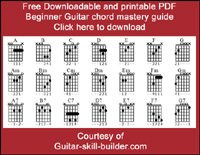
Alt text: Thumbnail image linking to Beginner Guitar Chords Chart, featuring basic guitar chords for beginners.
Dive into the Blues! The blues is an amazing genre to quickly sound fantastic on guitar. Download our printable Blues Guitar Chord Chart.
Left-Handed Guitarists! We haven’t forgotten you. Get your free downloadable, printable Left-Hand Guitar Chord Chart.
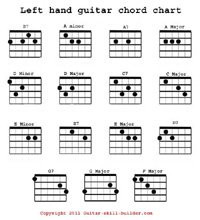
Alt text: Thumbnail image linking to Left-Hand Guitar Chord Chart, offering chord diagrams for left-handed players.
Explore more related pages on guitar-skill-builder.com:
-
Blues Guitar Chords: Learn how simple blues chords and progressions can get you sounding great fast.
-
Blues Guitar Scales: A blues solo sounds incredible over a power chord progression. Here are 5 simple scale patterns to make it happen.
Return to the Guitar-Skill-Builder.com Homepage.

Alt text: YouTube channel banner for Guitar Skill Builder, promoting guitar lessons and tutorials.
| Connect with Roy on Google+ | Welcome to guitar-skill-builder.com Reviews of beginner guitar lessons and tools to help you master the guitar. Can’t find it? – Full sitemap here |
|---|
| Share this page: What’s this? |
|---|
Enjoyed this page? Share it with fellow guitarists! Here’s how to link to this page:
- Click the HTML link code below.
- Copy and paste it into your blog, website, forum, Facebook, or anywhere you want to share this valuable resource.
